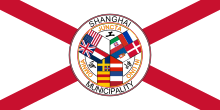Shanghai Municipal Police
| Shanghai Municipal Police | |
|---|---|
| Abbreviation | SMP |

Badge of the Shanghai Municipal Police
|
|

Flag of the Shanghai International Settlement
|
|
| Motto |
Latin: Omnia Juncta In Uno All joined as one |
| Agency overview | |
| Formed | September 1854 |
| Dissolved | 31 July 1943 |
| Employees |
|
| Legal personality | Governmental: Government agency |
| Jurisdictional structure | |
 |
|
| Map of police area | |
| Size | 22.598 km2 (8.725 sq mi) |
| Population | 1,074,794m (1934) |
| Legal jurisdiction | Shanghai International Settlement |
| Governing body | Shanghai Municipal Council |
| General nature | |
| Operational structure | |
| Headquarters | Central Police Station, Foochow Road, Shanghai |
| Child agencies |
|
| Facilities | |
| Stations | 14 |
The Shanghai Municipal Police (SMP; Chinese: 上海公共租界工部局警務處) was the police force of the Shanghai Municipal Council which governed the Shanghai International Settlement between 1854 and 1943, when the settlement was retroceded to Chinese control.
Initially composed of Europeans, most of them Britons, the force included Chinese after 1864, and was expanded over the next 90 years to include a Sikh Branch (established 1884), a Japanese contingent (from 1916) and a volunteer part-time special police (from 1918). In 1941 it acquired a Russian Auxiliary Detachment (formerly the Russian Regiment of the Shanghai Volunteer Corps).
The first detachment of 31 Europeans, effectively borrowed from the Hong Kong Police and led by Samuel Clifton, was recruited almost immediately after the formation of the Shanghai Municipal Council (SMC). These men were on patrol by September 1854. Further men were recruited from the Royal Irish Constabulary, London's Metropolitan Police and from the military presence in Shanghai itself, while a structure for recruitment of Britons in the United Kingdom eventually came about through the Shanghai Municipal Council's London agents, John Pook & Co. Once formalised, a steady stream of young men was recruited to serve in Shanghai. Promotion from the lower ranks of the force was, however, limited. Most of the force's commanders were recruited from British domestic or colonial police forces, although a cadre of young British men was recruited as cadets, and held senior ranks in the force in the 1910s-'30s.
In 1936, the last year of near-normal peacetime policing, the force totaled 4,739, men with 3,466 in the Chinese Branch, 457 serving in the Foreign Branch (predominantly British), 558 in the Sikh Branch and 258 in the Japanese Branch.
Though the force was mostly occupied in the routine business of crime prevention, detection and traffic control, it was also seen as the Settlement's first line of defense against Chinese nationalist activity. After the failure of the 1913 Second Revolution against the autocratic presidency of Yuan Shikai, the settlement was increasingly troubled by armed crime. In the build-up to, and aftermath of, the 1926-27 Nationalist Revolution, the force also struggled to contain a wave of armed robberies and politically motivated kidnappings. Throughout the 1930s it faced challenges from the Nationalist Government and the police force of the (Nationalist Chinese) City Government of Shanghai, particularly over rights to operate outside the historical bounds of the Concession and in cases of extraterritoriality.
...
Wikipedia
